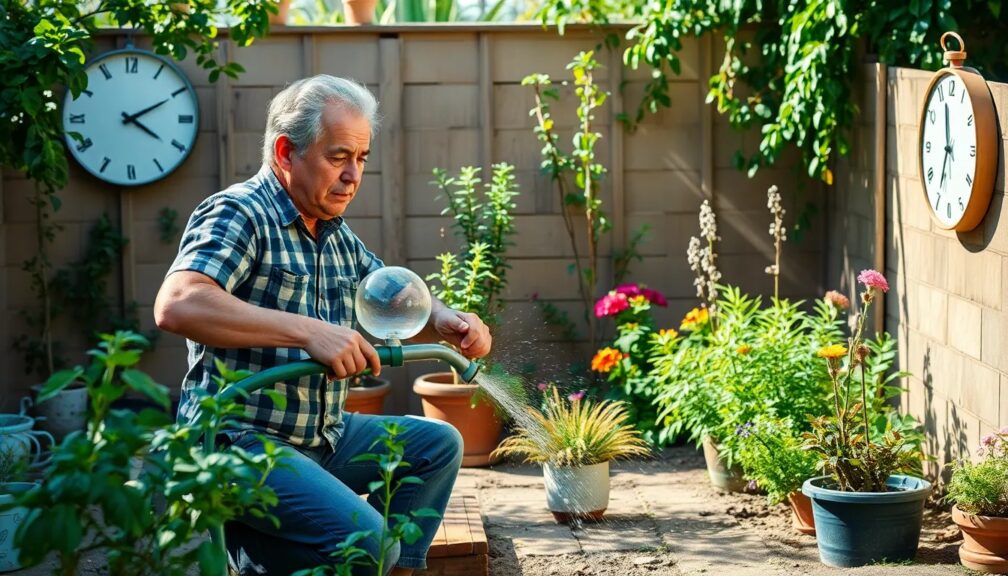What are 3 disadvantages of hand watering

- Welcome to our article on the disadvantages of hand watering. While hand watering your garden can seem like a simple and satisfying task, it may not always be the most effective or efficient method for maintaining healthy plants. In the following sections, we will explore three key drawbacks that gardeners may encounter with this traditional irrigation practice. From the inconsistency in water distribution to the time-consuming nature of the process, and the potential for over or under-watering, understanding these disadvantages can help you make more informed decisions about the best watering techniques for your garden's needs.
- What are the disadvantages of hand watering?
- How long should you hand water your lawn?
Welcome to our article on the disadvantages of hand watering. While hand watering your garden can seem like a simple and satisfying task, it may not always be the most effective or efficient method for maintaining healthy plants. In the following sections, we will explore three key drawbacks that gardeners may encounter with this traditional irrigation practice. From the inconsistency in water distribution to the time-consuming nature of the process, and the potential for over or under-watering, understanding these disadvantages can help you make more informed decisions about the best watering techniques for your garden's needs.
What are the disadvantages of hand watering?
Imagine nurturing your garden, expending countless hours only to discover your efforts might be leading to more harm than good. The traditional method of hand watering might seem like a therapeutic ritual, but beneath the surface, inefficiencies are lurking, potentially jeopardizing the health of your beloved plants.
Firstly, the error-prone nature of this watering technique can lead to uneven water distribution. Without uniformity, some plants drown in excess moisture while others are left parched, yearning for a drop of sustenance. The consequences? A garden that's a mosaic of vitality and withering despair.
In addition, hand watering is notoriously time-consuming. Those precious minutes spent hose in hand add up, stealing away time that could be invested in other gardening activities or enjoyed with loved ones. And let's not forget the physical toll—hours of standing, bending, and stretching can turn this peaceful activity into a back-breaking chore.
But the concerns don't end there. This method can lead to an excessive use of water, making it an environmentally unsustainable choice in the long run. With increasing water scarcity issues, every drop counts, and hand watering often leads to inadvertent wastage.
Watering by hand also tends to be less precise, leading to overwatering or underwatering. This imprecision not only affects plant health but can also pave the way for diseases and pests to take hold, thriving in the unstable conditions created by inconsistent watering.
Lastly, consider the economic aspect. While hand watering might seem cost-effective, the potential damage to your plants, along with the increased water bills, can make this method far more expensive than it initially appears.
The quest for a lush, thriving garden is filled with hidden pitfalls, and hand watering might just be one of those deceptively tranquil but perilous paths. Could there be a better way to nurture your garden without these hidden drawbacks? Stay tuned as we delve deeper into alternatives that promise to revolutionize the way you hydrate your green haven.
How long should you hand water your lawn?
Discover the secret to a lush, vibrant lawn that will be the envy of your neighborhood. The answer lies not in the mere act of watering, but in the mastery of timing and technique. It's a delicate balance that, when perfected, can transform your grass from lackluster to luxurious.
First, let's delve into the art of hydration frequency. Did you know that your watering schedule should evolve with the seasons? The needs of your lawn in the spring differ vastly from the scorching demands of summer. Embrace the rhythm of nature and your lawn will not only survive, but thrive.
Now, brace yourself for a revelation – the duration of each watering session is crucial. But don't worry, you don't need to stand for hours, hose in hand, to achieve perfection. The solution is surprisingly simple and hinges on one key principle: deep, infrequent watering.
Imagine the roots of your grass reaching down, deep into the soil, in search of moisture. This is the magic of proper watering technique, encouraging a robust root system that is resilient against drought and disease. But how long is just long enough to encourage this growth without overdoing it? The answer might shock you, and it's something you can't afford to miss.
Stay with us as we unveil the golden rule of hand watering – a guideline that is so straightforward, yet so often overlooked. Say goodbye to the guesswork and hello to the lush lawn of your dreams. Your perfect green oasis is just within reach, and we're here to guide you every step of the way. Prepare to unlock the full potential of your lawn, one satisfying soak at a time.
Is it better to hand water or use a sprinkler?
Discover the ultimate secret to a lush, vibrant garden that your neighbors will envy. Imagine stepping outside to a personal oasis, where every plant flourishes. You've seen others master this art, but the key lies in the age-old question: To hand water or to employ the technological ease of a sprinkler?
The answer is not just about quenching your garden's thirst, it's about maximizing growth, optimizing your time, and ensuring every drop counts.
With hand watering, you connect with nature, attentively catering to each plant's needs. The control is unmatched, allowing for precision and a mindful approach to water usage. But there's a catch – it's time-consuming and often inconsistent, making you wonder if there's a better way.
Enter the sprinkler system. An orchestra of water droplets dances across your lawn, promising ease and uniformity. Efficiency at its finest. However, beneath the surface lurks the potential for overwatering and the overlooked plight of your water bill.
So, what's the verdict? The tantalizing truth awaits, and with the right knowledge, you'll unlock a garden paradise. Whether you're a green-thumbed veteran or a budding gardener, the journey to mastering your garden's hydration is fraught with choices that could make or break your botanical dreams.
Stay tuned to unearth the pros and cons of each method, strategic tips for every garden type, and the ultimate watering techniques that will transform your garden into a beacon of green beauty. The decision you make after this could be the defining factor between a garden that simply survives and one that thrives beyond imagination.
What are the disadvantages of a watering can?
Discover the hidden drawbacks of the seemingly innocuous watering can that every gardener should be aware of. Often hailed as a staple tool for its simplicity and functionality, there's more to this essential piece of gardening equipment than meets the eye.
First, consider the issue of capacity limitations. Standard watering cans hold a finite amount of water, which means constant trips back and forth to the faucet for anyone tending to a larger garden. This not only consumes time but can also lead to physical strain, especially when the can is filled to the brim.
Furthermore, the very design of a watering can may lead to inefficient water distribution. With a traditional spout, it's all too easy to overwater some plants while leaving others parched. This inconsistency can be a death sentence for sensitive flora that thrives on precision in watering.
And let's not overlook the ergonomic challenges. A full watering can be quite heavy, and prolonged use can result in muscle fatigue or even injury. The strain on your back, arms, and hands can turn the joy of gardening into a painful chore.
But perhaps the most surprising disadvantage is the potential for water waste. With spillage common due to imprecise pour spouts and evaporation from surface runoff, watering cans are not as eco-friendly as you might think.
Stay tuned to unearth alternative solutions that address these shortcomings, ensuring your gardening remains a pleasure, not a pain. Could there be a better way to tend to your plants while also saving time, conserving water, and protecting your body from strain? The answer lies just around the corner.
What are 3 disadvantages of hand watering plants
Imagine nurturing a garden that's the envy of the neighborhood, but are you aware of the hidden pitfalls of your watering routine? Hand watering, a practice as old as gardening itself, may seem like the most natural way to provide your plants with the life-giving moisture they crave. However, beneath the tranquil surface of this time-honored method lie inefficiencies that could be silently undermining your garden's potential.
Inconsistency reigns as the first drawback, one you might not notice until your plants start displaying signs of distress. Without a measured approach, some areas may become waterlogged while others barely sip enough to survive. This variability can lead to erratic growth patterns, leaving your garden looking less than perfect.
Secondly, the time consumption element cannot be overlooked. Each minute spent with hose or watering can in hand is a minute not spent on other garden improvements or enjoying the fruits of your labor. The relentless ticking of the clock as you water could be the time you use to prune, plant, or simply relax.
Lastly, the specter of water waste looms. As precious droplets evaporate in the midday sun or run off where they aren't needed, your water bill creeps up, and the environment bears the cost of unnecessary consumption.
Now, while you ponder the hidden costs of hand watering, imagine a garden thriving with uniform hydration, your time freed up, and resources used wisely. The solutions are within reach, and the next steps could revolutionize the way you nurture your green oasis. Ready to dive deeper into the art of efficient plant care? Your garden's future hangs in the balance, and what you learn next might just tip the scales.
Consejo final: If you're considering hand watering for your garden or plants, remember to weigh the potential downsides: it can be time-consuming, may lead to inconsistent water distribution, and generally requires a lot of effort, especially for large areas. Automated irrigation systems could be a worthwhile investment for efficiency and plant health in the long term. May your garden thrive with whichever method you choose. Wishing you a flourishing and rewarding gardening experience!
 What is the best tool to remove grass from yard
What is the best tool to remove grass from yard Why is forking a lawn bad
Why is forking a lawn bad How do I get rid of grass in my vegetable garden naturally
How do I get rid of grass in my vegetable garden naturally What is the best tool to trim small shrubs
What is the best tool to trim small shrubs What is the best tool to cut back perennials
What is the best tool to cut back perennialsIf you want to know more about similar articles like What are 3 disadvantages of hand watering you can visit category Gardening Tools.
Deja una respuesta